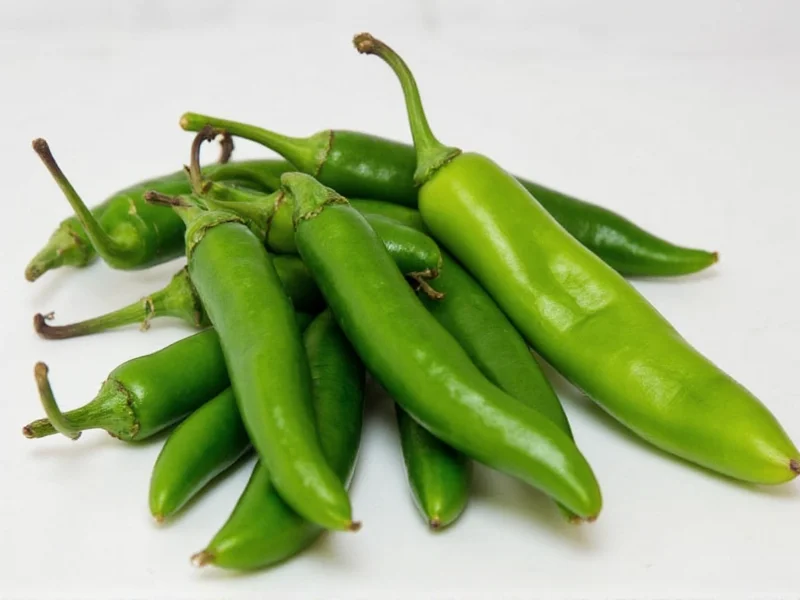When comparing what is spicier serrano or jalapeño, the answer lies in scientific measurement of capsaicin content. The Scoville scale, which measures the concentration of capsaicinoids responsible for heat in chili peppers, provides objective data that settles this common culinary question once and for all.
Understanding Pepper Heat Measurement
The Scoville scale remains the gold standard for measuring chili pepper heat. Developed by pharmacist Wilbur Scoville in 1912, this measurement system determines how much sugar-water solution is needed to dilute the capsaicin in a pepper until the heat becomes undetectable to human testers. Modern high-performance liquid chromatography (HPLC) now provides more precise measurements, but results are still converted to Scoville Heat Units for consumer understanding.
Serrano Pepper Profile
Serrano peppers (Capsicum annuum) originated in the mountainous regions of Mexico, specifically in the state of Puebla. Their name comes from the Spanish word "sierra," meaning mountain range. These small, tapered peppers typically measure 1-4 inches in length with a bright green color that matures to red, orange, or brown.
The heat profile of serranos delivers an immediate, sharp burn that peaks quickly and fades relatively fast compared to some other hot peppers. Their flavor profile includes bright, grassy notes with a clean heat that doesn't overwhelm other ingredients. Serranos work exceptionally well in salsas, guacamole, and as a garnish for tacos and other Mexican dishes.
Jalapeño Pepper Profile
Jalapeños (Capsicum annuum) take their name from Xalapa, the capital city of Veracruz, Mexico. These medium-sized peppers typically measure 2-3.5 inches long and 1 inch in diameter, with a smooth, shiny skin that transitions from dark green to bright red as they mature.
Jalapeños provide a more moderate heat experience with a gradual build-up rather than an immediate punch. Their flavor profile features earthy, slightly sweet notes with vegetal undertones. This balanced heat and flavor make jalapeños incredibly versatile in cooking - they're perfect for poppers, salsas, pickling, and adding subtle heat to various dishes without overwhelming other flavors.
Direct Comparison: Serrano vs Jalapeño Heat Levels
| Pepper Characteristic | Serrano Pepper | Jalapeño Pepper |
|---|---|---|
| Scoville Heat Units (SHU) | 10,000-23,000 | 2,500-8,000 |
| Relative Heat Level | 3-10x hotter than jalapeño | Baseline for medium heat |
| Heat Onset | Immediate, sharp burn | Gradual build-up |
| Heat Duration | Shorter duration | Longer-lasting warmth |
| Flavor Profile | Bright, grassy, clean heat | Earthy, slightly sweet, vegetal |
| Common Culinary Uses | Salsas, guacamole, garnishes | Poppers, pickling, sauces |
Practical Implications in Cooking
Understanding which is hotter serrano or jalapeño has significant implications for home cooks and professional chefs alike. When substituting one for the other in recipes, you'll need to adjust quantities accordingly. As a general rule, use one jalapeño for every three serranos called for in a recipe to maintain similar heat levels.
The heat concentration also varies within each pepper. The placenta (the white membrane holding the seeds) contains the highest concentration of capsaicin, so removing seeds and membranes from either pepper will significantly reduce heat. However, serranos maintain their heat advantage even when prepared identically to jalapeños.
Substitution Guidance for Home Cooks
When deciding is serrano hotter than jalapeño for cooking purposes, consider these practical substitution guidelines:
- For mild heat: Use jalapeños with seeds removed
- For medium heat: Use jalapeños with seeds intact or mild serranos with seeds removed
- For significant heat: Use serranos with seeds intact
- When substituting: 1 serrano ≈ 3 jalapeños in heat intensity
Remember that growing conditions significantly affect actual heat levels. Peppers grown in stressful conditions (less water, more sun) typically develop higher capsaicin concentrations. This means two serranos from different sources might vary considerably in heat, though they'll still generally be hotter than jalapeños.
Safety Considerations When Handling Hot Peppers
Working with spicier serrano compared to jalapeño requires proper safety precautions. The capsaicin that creates heat can cause skin irritation and severe discomfort if it contacts eyes or other sensitive areas. Always follow these safety tips:
- Wear disposable gloves when handling serranos
- Avoid touching your face while preparing hot peppers
- Wash hands thoroughly with soap and water after handling
- Cut peppers on a dedicated cutting board that won't be used for other foods immediately
- If experiencing skin irritation, use milk or oil to neutralize capsaicin rather than water
Understanding the significant heat difference between these peppers helps prevent culinary disasters. Many home cooks mistakenly use equal quantities of serranos and jalapeños, resulting in unexpectedly fiery dishes that can overwhelm other flavors.
Regional Variations and Cultivars
While standard serranos consistently outrank jalapeños on the heat scale, certain cultivars can alter this relationship slightly. Some jalapeño varieties like the 'Mucho Nacho' have been bred for higher heat, potentially reaching up to 10,000 SHU in optimal conditions. Conversely, some milder serrano varieties might dip toward the lower end of their heat range.
However, even in these edge cases, serranos maintain their position as the hotter pepper. When comparing what makes serrano spicier than jalapeño, the biological structure of serranos simply produces more capsaicin across virtually all growing conditions and varieties.
Final Thoughts on Pepper Selection
The choice between serrano and jalapeño ultimately depends on your desired heat level and flavor profile. For authentic Mexican salsas where heat should shine through, serranos are the traditional choice. For dishes where you want noticeable but manageable heat that complements rather than dominates, jalapeños work better.
Understanding the substantial heat difference between these peppers empowers you to make informed decisions in the kitchen. Whether you're wondering why is serrano hotter than jalapeño or simply need to choose the right pepper for your recipe, this knowledge helps ensure your culinary creations achieve the perfect balance of flavor and heat.











 浙公网安备
33010002000092号
浙公网安备
33010002000092号 浙B2-20120091-4
浙B2-20120091-4